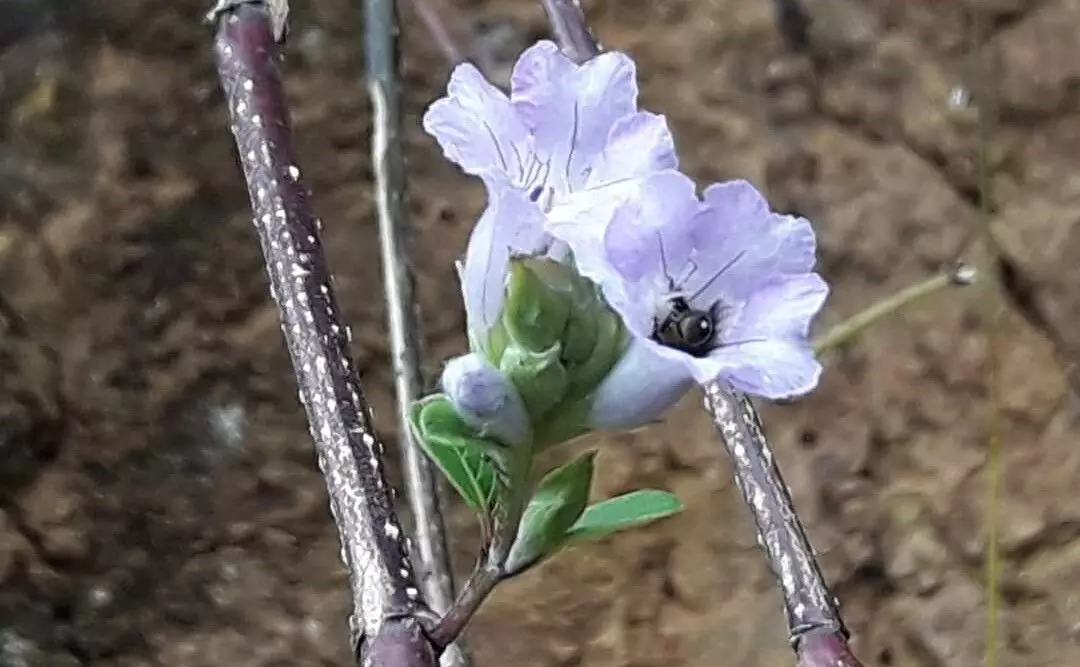`The earth laughs in flowers’: A 12-year wait ends, Neelakurunji blooms again to enliven souls
The single flower is rather plain looking and without any scent but the en-masse blooming is a breathtaking sight of unsurpassed beauty.
By Beyniaz Edulji
Blue flowers
Hyderabad: Neelakurunji, a flower that blooms once in 12 years high up in the Western Ghats, has long fascinated scientists as well as visitors. It is these purple-blue flowers that have given the Nilgiri mountain range its name as ‘Neel’ means blue and ‘Giri’ means Mountains.
The single flower is rather plain looking and without any scent but the en-masse blooming is a breathtaking sight of unsurpassed beauty.
Mass Flowering
Neelakurinji (Strobilanthes kunthiana), has a rare blooming cycle. The plant flowers only once every 12 years, creating a glorious purple-blue landscape. This plant is native to the Western Ghats, a UNESCO World Heritage site in India, and is mostly found in the Shola forests of high-altitude regions of Kerala, Karnataka, and Tamil Nadu.
It blooms only at an altitude of 1300 to 2400 meters. It is unique in that it flowers gregariously, which is a phenomenon where all populations of a particular species flower all at once, regardless of location. It is also known as mass flowering or synchronous blooming.
Threatened Species
Neelakurinji has been included on the IUCN (International Union for Conservation of Nature) official Red List of threatened species. This is the first-ever Global Red List assessment for this flagship species of the montane grasslands of southwest India.
Though considered threatened, the shrub was not evaluated against IUCN global standards until recently. The mass blooming of the flower in the Western Ghats, once in 12 years attracts tourists in droves. Forest staff is deployed to protect the places where these flowers bloom.
Tamil Nadu
The blooming has started this year in Tamil Nadu near Ooty (Udhagamandalam) and Kotagiri, officials have said. Strobilanthes kunthiana popularly known as Neelakurunji is now in bloom.
The Nilgiris forest division has deployed personnel from the forest department to prevent tourists and residents from disturbing the gregarious flowering of the Neelakurinji plants near Udhagamandalam. The latest global assessment confirms its threatened status in the Vulnerable (Criteria A2c) category of the IUCN. The mass blooming of the flower is a huge tourist attraction.
The assigned scientific name is Strobilanthes kunthianus. These flowers were first mentioned in the 19th Century. The species name 'kunthianus' is derived from the name of German botanist Kunth who observed these flowers, although some say it is named after the Kunthi River. In dry weather conditions, Neelakurinji flowers can last up to three months after blooming.
Beneficial for the Nilgiri Biosphere
Neelakurinji helps in maintaining the ecological balance of the fragile Nilgiri Biosphere. Although it has no scent, it is its vivid color and mass flowering that attracts and provides a feast for butterflies, honey bees, and other insects. This rare honey from Neelakurinji is said to last for more than 15 years.
Tourist attraction
The mass blooming of the flower is a huge tourist attraction. The blooming was reported recently, though not in large areas, at Peerumade in Idukki, Kerala. The last time this flowered in Munnar, over 4 lakh tourists visited during the blooming season.
Mettakurunji in Idukki, Kerala
The Idukki hills in Kerala have turned blue as the rare Mettukurinji blooms have started. The Mettukurinji blooms every 6 to 7 years at an elevation of 600 to 1000 meters above sea level, unlike Neelakurinji, which blooms every 12 years at a higher elevation. Tourists have started arriving at the Kalyanathandu hills in Idukki where Mettukurinji has now bloomed.
Known as Mettukurinji, another rare species of Kurinji, the Strobilanthes sessilis variety, has burst into bloom and has captivated the local people as well as tourists. Mettukurinji blooms are present in the Parunthumpara hills too.